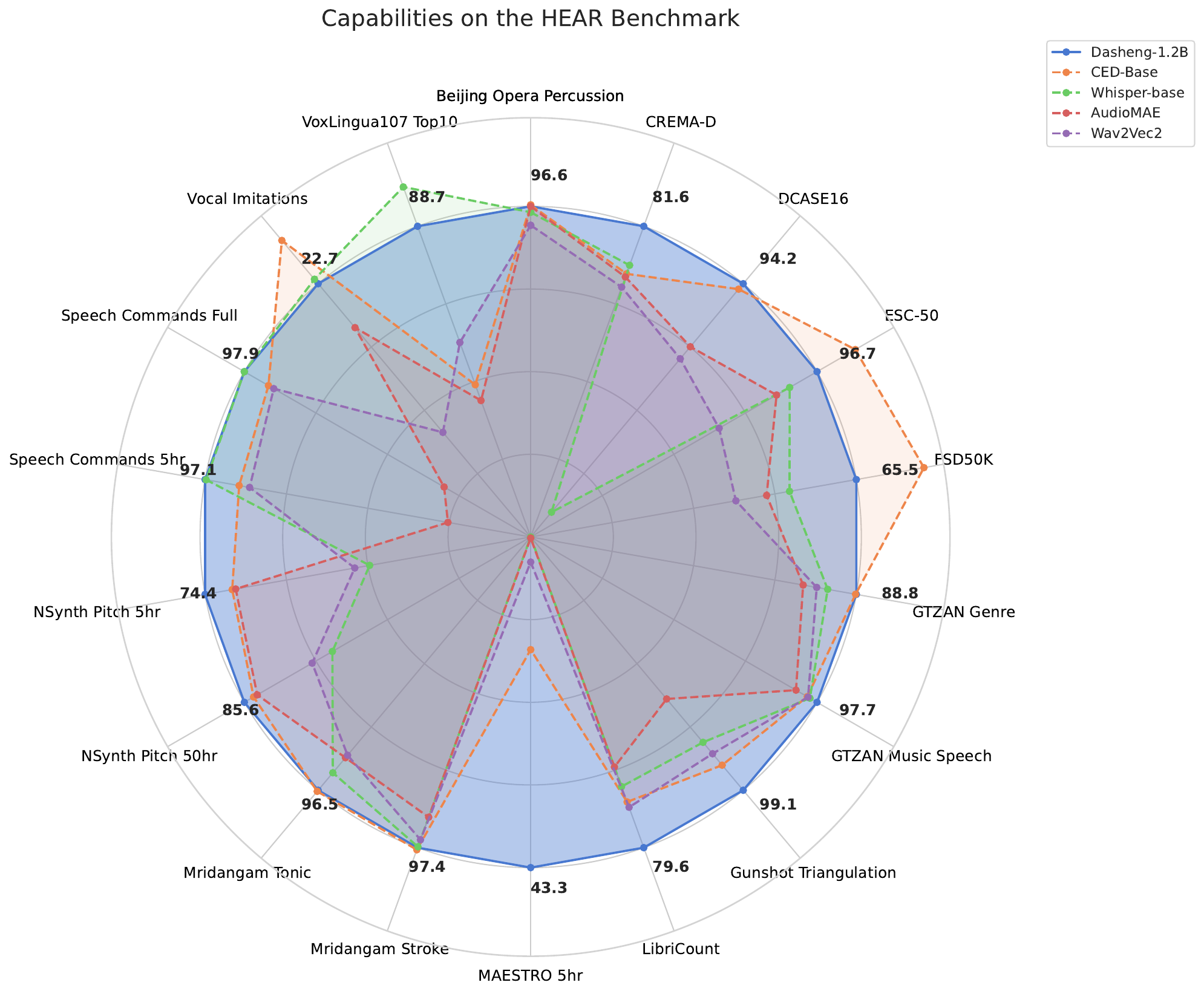Official PyTorch code for Deep Audio-Signal Holistic Embeddings
Scaling up masked audio encoder learning for general audio classification





python3 -m pip install dasheng
python3 -c "from dasheng import dasheng_base; import torch; model = dasheng_base().eval(); features=model(torch.randn(1, 16000))"This repo provides checkpoints for the Interspeech 2024 paper Scaling up masked audio encoder learning for general audio classification. The goal of this work is to investigate the scalability of masked autoencoders for audio. Prior work did not scale beyond 10,000 hours of audio, while Dasheng used 272,000 hours of training data.
Please see here for usage instructions.
Dasheng models have been trained on 272k hours of general audio, mainly VGGSound, Audioset, MTG-Jamendo and ACAV100M.
Models with their evaluation results on the HEAR benchmark, averaged across different domains.
| Model | Parameters (M) | Environment Sounds | Speech | Music |
|---|---|---|---|---|
| Dasheng-Base | 86 | 80.2 | 72.5 | 84.0 |
| Dasheng-0.6B | 600 | 82.4 | 74.9 | 84.0 |
| Dasheng-1.2B | 1200 | 83.2 | 75.7 | 84.9 |
| AudioMAE | 86 | 61.7 | 38.7 | 72.7 |
| Whisper-Base-V1 | 74 | 52.5 | 73.1 | 69.1 |
| WavLM-Large | 330 | 71.4 | 72.2 | 65.0 |
| Wav2vec-large-100k-voxpopuli | 300 | 62.5 | 63.6 | 69.5 |
| Data2Vec-Audio-Large | 300 | 41.1 | 60.5 | 55.0 |
Performance of features without parameterized training.
| ESC50 | FSDKaggle18 | NSynth Instrument | Speech Commands 1 | Speech Commands 2 | US8k | VoxCeleb1 | RAVDESS-Speech | FluentSpeechCommands | |
|---|---|---|---|---|---|---|---|---|---|
| MSM-MAE | 2 | 2.18 | 20.58 | 3.7 | 1.5 | 11.5 | 0.12 | 6.77 | 1.85 |
| MelSpec | 18.4 | 38.5 | 35.5 | 3.7 | 1.5 | 40.39 | 5.26 | 29.65 | 9.97 |
| CED-Base | 95.35 | 85.06 | 74.41 | 79.78 | 62.66 | 87.06 | 7.02 | 52.78 | 16.61 |
| AudioMAE | 53.05 | 43.38 | 67.21 | 56.87 | 5.9 | 58.18 | 2.9 | 28.68 | 7.59 |
| WavLM-Large | 51.3 | 60.87 | 96.97 | 92.69 | 58.67 | 28.54 | 51.39 | 83.28 | |
| Wav2vec-large-100k-voxpopuli | 44 | 59.5 | 60.42 | 80.86 | 66.61 | 59.84 | 18.22 | 45.76 | 30.48 |
| Dasheng-Base | 61.9 | 70.31 | 70.02 | 93.55 | 86 | 73.87 | 34.21 | 58.12 | 52.33 |
| Dasheng-0.6B | 66.55 | 72.06 | 70.87 | 93.36 | 87.27 | 75.92 | 37.78 | 61.81 | 57.63 |
| Dasheng-1.2B | 68.55 | 72.06 | 71.19 | 95.9 | 90.9 | 77.71 | 39.39 | 61.94 | 62.38 |
Install the package.
python3 -m pip install dashengpython3 -m pip install dasheng[train]# The three models of the paper
from dasheng import dasheng_base, dasheng_06B, dasheng_12B
model = dasheng_base()Forward some audio data (note should be 16khz)
import torch
model = model.eval()
features = model(torch.randn(1, 16000))
print(features.shape)Install dependencies:
python3 -m pip install dasheng[train]We rely on the excellent webdataset library for I/O.
Thus one simply needs to pack their data into a bunch of .tar files.
A simple example of such a file would be:
find DIR -type f -name '*flac' | tar -rvf data.tgz -T -We also provide a simple script [wavlist_to_tar] that automates this process, which is installed with the package.
wavlist_to_tar your_data.tsv shards/Creating your_data.tsv is simple:
find data -type f | awk 'BEGIN{print "filename"} {print}' > your_data.tsvTo train one should first adjust the config in dasheng/train/config/*yaml accordingly, by adding their training data.
python3 dasheng/train/train.py dasheng/train/config/dasheng_base.yamlMultiGPU support is realized using Accelerate
accelerate launch --mixed_precision='bf16' dasheng/train/train.py dasheng/train/config/dasheng_base.yamlYes, the performance for the base model is 49.7 mAP. One can use it as follows:
from typing import Any, Mapping
import dasheng
import torch
class DashengAudiosetClassifier(torch.nn.Module):
def __init__(self) -> None:
super().__init__()
self.dashengmodel = dasheng.dasheng_base()
self.classifier = torch.nn.Sequential(torch.nn.LayerNorm(self.dashengmodel.embed_dim), torch.nn.Linear(self.dashengmodel.embed_dim, 527))
def load_state_dict(self, state_dict: Mapping[str, Any], strict: bool = True, assign: bool = False):
self.dashengmodel.load_state_dict(state_dict, strict=False)
for_classifier_dict = {}
for k,v in state_dict.items():
if 'outputlayer' in k:
for_classifier_dict[k.replace('outputlayer.','')] = v
self.classifier.load_state_dict(for_classifier_dict)
return self
def forward(self, x):
x = self.dashengmodel(x).mean(1)
return self.classifier(x).sigmoid()
mdl = DashengAudiosetClassifier()
check = torch.hub.load_state_dict_from_url('https://zenodo.org/records/13315686/files/dasheng_audioset_mAP497.pt?download=1',map_location='cpu')
mdl.load_state_dict(check)
prediction = mdl(torch.randn(1,16000))@inproceedings{dinkel2024dasheng,
title={Scaling up masked audio encoder learning for general audio classification},
author={Dinkel, Heinrich and Yan, Zhiyong and Wang, Yongqing and Zhang, Junbo and Wang, Yujun and Wang, Bin},
booktitle={Interspeech 2024},
year={2024}
}


